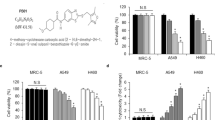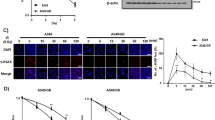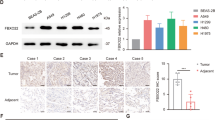Abstract
Radiotherapy is the common treatment of choice for locally advanced lung cancer, but the radioresistance of lung cancer remains a significant therapeutic obstacle. We previously demonstrated that adenovirus-mediated inhibitor of growth 4 (ING4) tumor suppressor gene delivery (AdVING4) can chemosensitize human hepatocarcinoma cells to anticancer drug cisplatin (CDDP). However, its radiosensitizing effects in cancer therapy are largely elusive. In the present study, we investigated the therapeutic efficacy of AdVING4 gene therapy combined with ionizing radiotherapy for SPC-A1 human non-small-cell lung cancer (NSCLC) cells in vitro and in vivo in athymic nude mice, and also elucidated its underlying mechanisms. We found that AdVING4 gene therapy plus radiotherapy induced synergistic tumor suppression and apoptosis in in vitro SPC-A1 human NSCLC cells and in vivo SPC-A1 xenografted tumors s.c. implanted in athymic nude mice. Mechanistically, AdVING4 combined with radiation resulted in a substantial upregulation of Bax, Fas, FasL and Cleaved Caspase-3, and downregulation of Bcl-2 in SPC-A1 human NSCLC xenografted tumors. In addition, AdVING4 plus radiation synergistically reduced the tumor vessel CD34 expression and microvessel density (MVD) in vivo. Most importantly, AdVING4 potentially blocked the radiation-induced enhancement of cyclooxygenase-2 and survivin radioresistant factors, and vascular endothelial growth factor and IL-8 proangiogenic factors. The enhanced antitumor effects elicited by AdVING4 plus radiotherapy were closely associated with the cooperative activation of intrinsic and extrinsic apoptotic pathways, and synergistic inhibition of tumor angiogenesis. Thus, our results suggested that AdVING4 combined with radiotherapy may be a feasible and effective strategy for treatment of radioresistant NSCLC and other cancers.
This is a preview of subscription content, access via your institution
Access options
Subscribe to this journal
Receive 12 print issues and online access
$259.00 per year
only $21.58 per issue
Buy this article
- Purchase on Springer Link
- Instant access to full article PDF
Prices may be subject to local taxes which are calculated during checkout






Similar content being viewed by others
References
Jemal A, Siegel R, Ward E, Hao Y, Xu J, Thun MJ . Cancer statistics. 2009 CA Cancer J Clin 2009; 59: 225–249.
Gridelli C, Langer C, Maione P, Rossi A, Schild SE . Lung cancer in the elderly. J Clin Oncol 2007; 25: 1898–1907.
Gandara D, Narayan S, Lara PN, Goldberg Z, Davies A, Lau DH et al. Integration of novel therapeutics into combined modality therapy of locally advanced non-small cell lung cancer. Clin Cancer Res 2005; 11: 5057s–5062s.
Spiro SG, Silvestri GA . One hundred years of lung cancer. Am J Respir Crit Care Med 2005; 172: 523–529.
Garkavtsev I, Kozin SV, Chernova O, Xu L, Winkler F, Brown E et al. The candidate tumour suppressor protein ING4 regulates brain tumour growth and angiogenesis. Nature 2004; 428: 328–332.
Gunduz M, Nagatsuka H, Demircan K, Gunduz E, Cengiz B, Ouchida M et al. Frequent deletion and down-regulation of ING4, a candidate tumor suppressor gene at 12p13, in head and neck squamous cell carcinomas. Gene 2005; 356: 109–117.
Fang F, Luo LB, Tao YM, Wu F, Yang LY . Decreased expression of inhibitor of growth 4 correlated with poor prognosis of hepatocellular carcinoma. Cancer Epidemiol Biomarkers Prev 2009; 18: 409–416.
Wang QS, Li M, Zhang LY, Jin Y, Tong DD, Yu Y et al. Down-regulation of ING4 is associated with initiation and progression of lung cancer. Histopathology 2010; 57: 271–281.
Tapia C, Zlobec I, Schneider S, Kilic E, Guth U, Bubendorf L et al. Deletion of the inhibitor of growth 4 (ING4) tumor suppressor gene is prevalent in human epidermal growth factor 2 (HER2)-positive breast cancer. Hum Pathol 2011; 42: 983–990.
Kim S, Welm AL, Bishop JM . A dominant mutant allele of the ING4 tumor suppressor found in human cancer cells exacerbates MYC-initiated mouse mammary tumorigenesis. Cancer Res 2010; 70: 5155–5162.
Moreno A, Palacios A, Orgaz JL, Jimenez B, Blanco FJ, Palmero I . Functional impact of cancer-associated mutations in the tumor suppressor protein ING4. Carcinogenesis 2010; 31: 1932–1938.
Kim S, Chin K, Gray JW, Bishop JM . A screen for genes that suppress loss of contact inhibition: identification of ING4 as a candidate tumor suppressor gene in human cancer. Proc Natl Acad Sci USA 2004; 101: 16251–16256.
Shiseki M, Nagashima M, Pedeux RM, Kitahama-Shiseki M, Miura K, Okamura S et al. p29ING4 and p28ING5 bind to p53 and p300, and enhance p53 activity. Cancer Res 2003; 63: 2373–2378.
Zhang X, Xu LS, Wang ZQ, Wang KS, Li N, Cheng ZH et al. ING4 induces G2/M cell cycle arrest and enhances the chemosensitivity to DNA-damage agents in HepG2 cells. FEBS Lett 2004; 570: 7–12.
Unoki M, Shen JC, Zheng ZM, Harris CC . Novel splice variants of ING4 and their possible roles in the regulation of cell growth and motility. J Biol Chem 2006; 281: 34677–34686.
Xie Y, Zhang H, Sheng W, Xiang J, Ye Z, Yang J . Adenovirus-mediated ING4 expression suppresses lung carcinoma cell growth via induction of cell cycle alteration and apoptosis and inhibition of tumor invasion and angiogenesis. Cancer Lett 2008; 271: 105–116.
Li J, Li G . Cell cycle regulator ING4 is a suppressor of melanoma angiogenesis that is regulated by the metastasis suppressor BRMS1. Cancer Res 2010; 70: 10445–10453.
Ozer A, Wu LC, Bruick RK . The candidate tumor suppressor ING4 represses activation of the hypoxia inducible factor (HIF). Proc Natl Acad Sci USA 2005; 102: 7481–7486.
Colla S, Tagliaferri S, Morandi F, Lunghi P, Donofrio G, Martorana D et al. The new tumor-suppressor gene inhibitor of growth family member 4 (ING4) regulates the production of proangiogenic molecules by myeloma cells and suppresses hypoxia-inducible factor-1 alpha (HIF-1alpha) activity: involvement in myeloma-induced angiogenesis. Blood 2007; 110: 4464–4475.
Shen JC, Unoki M, Ythier D, Duperray A, Varticovski L, Kumamoto K et al. Inhibitor of growth 4 suppresses cell spreading and cell migration by interacting with a novel binding partner, liprin alpha1. Cancer Res 2007; 67: 2552–2558.
Li J, Martinka M, Li G . Role of ING4 in human melanoma cell migration, invasion and patient survival. Carcinogenesis 2008; 29: 1373–1379.
Xie Y, Sheng W, Miao J, Xiang J, Yang J . Enhanced antitumor activity by combining an adenovirus harboring ING4 with cisplatin for hepatocarcinoma cells. Cancer Gene Ther 2011; 18: 176–188.
Nishikawa T, Ramesh R, Munshi A, Chada S, Meyn RE . Adenovirus-mediated mda-7 (IL24) gene therapy suppresses angiogenesis and sensitizes NSCLC xenograft tumors to radiation. Mol Ther 2004; 9: 818–828.
Zhang X, Cheung RM, Komaki R, Fang B, Chang JY . Radiotherapy sensitization by tumor-specific TRAIL gene targeting improves survival of mice bearing human non-small cell lung cancer. Clin Cancer Res 2005; 11: 6657–6668.
Zhao Y, Su C, Zhai H, Tian Y, Sheng W, Miao J et al. Synergistic antitumor effect of adenovirus-mediated hING4 gene therapy and (125)I radiation therapy on pancreatic cancer. Cancer Lett 2012; 316: 211–218.
Weidner N . Current pathologic methods for measuring intratumoral microvessel density within breast carcinoma and other solid tumors. Breast Cancer Res Treat 1995; 36: 169–180.
Wang W, Qin SK, Chen BA, Chen HY . Experimental study on antitumor effect of arsenic trioxide in combination with cisplatin or doxorubicin on hepatocellular carcinoma. World J Gastroenterol 2001; 7: 702–705.
Brown JR, DuBois RN . Cyclooxygenase as a target in lung cancer. Clin Cancer Res 2004; 10: 4266s–4269s.
Kelly RJ, Lopez-Chavez A, Citrin D, Janik JE, Morris JC . Impacting tumor cell-fate by targeting the inhibitor of apoptosis protein survivin. Mol Cancer 2011; 10: 35.
Hanahan D, Folkman J . Patterns and emerging mechanisms of the angiogenic switch during tumorigenesis. Cell 1996; 86: 353–364.
Lee JM, Bernstein A . p53 mutations increase resistance to ionizing radiation. Proc Natl Acad Sci USA 1993; 90: 5742–5746.
Hida T, Yatabe Y, Achiwa H, Muramatsu H, Kozaki K, Nakamura S et al. Increased expression of cyclooxygenase 2 occurs frequently in human lung cancers, specifically in adenocarcinomas. Cancer Res 1998; 58: 3761–3764.
Cao C, Mu Y, Hallahan DE, Lu B . XIAP and survivin as therapeutic targets for radiation sensitization in preclinical models of lung cancer. Oncogene 2004; 23: 7047–7052.
Brognard J, Clark AS, Ni Y, Dennis PA . Akt/protein kinase B is constitutively active in non-small cell lung cancer cells and promotes cellular survival and resistance to chemotherapy and radiation. Cancer Res 2001; 61: 3986–3997.
Zheng M, Morgan-Lappe SE, Yang J, Bockbrader KM, Pamarthy D, Thomas D et al. Growth inhibition and radiosensitization of glioblastoma and lung cancer cells by small interfering RNA silencing of tumor necrosis factor receptor-associated factor 2. Cancer Res 2008; 68: 7570–7578.
Kim WY, Oh SH, Woo JK, Hong WK, Lee HY . Targeting heat shock protein 90 overrides the resistance of lung cancer cells by blocking radiation-induced stabilization of hypoxia-inducible factor-1alpha. Cancer Res 2009; 69: 1624–1632.
Camphausen K, Moses MA, Beecken WD, Khan MK, Folkman J, O’Reilly MS . Radiation therapy to a primary tumor accelerates metastatic growth in mice. Cancer Res 2001; 61: 2207–2211.
Moeller BJ, Cao Y, Li CY, Dewhirst MW . Radiation activates HIF-1 to regulate vascular radiosensitivity in tumors: role of reoxygenation, free radicals, and stress granules. Cancer Cell 2004; 5: 429–441.
Danial NN, Korsmeyer SJ . Cell death: critical control points. Cell 2004; 116: 205–219.
Gorski DH, Beckett MA, Jaskowiak NT, Calvin DP, Mauceri HJ, Salloum RM et al. Blockage of the vascular endothelial growth factor stress response increases the antitumor effects of ionizing radiation. Cancer Res 1999; 59: 3374–3378.
Harris AL . Hypoxia—a key regulatory factor in tumour growth. Nat Rev Cancer 2002; 2: 38–47.
Russell JS, Tofilon PJ . Radiation-induced activation of nuclear factor-kappaB involves selective degradation of plasma membrane-associated I(kappa)B(alpha). Mol Biol Cell 2002; 13: 3431–3440.
Madhusoodhanan R, Natarajan M, Veeraraghavan J, Herman TS, Aravindan N . NFkappaB activity and transcriptional responses in human breast adenocarcinoma cells after single and fractionated irradiation. Cancer Biol Ther 2009; 8: 765–773.
Davis TW, O'Neal JM, Pagel MD, Zweifel BS, Mehta PP, Heuvelman DM et al. Synergy between celecoxib and radiotherapy results from inhibition of cyclooxygenase-2-derived prostaglandin E2, a survival factor for tumor and associated vasculature. Cancer Res 2004; 64: 279–285.
Pold M, Zhu LX, Sharma S, Burdick MD, Lin Y, Lee PP et al. Cyclooxygenase-2-dependent expression of angiogenic CXC chemokines ENA-78/CXC Ligand (CXCL) 5 and interleukin-8/CXCL8 in human non-small cell lung cancer. Cancer Res 2004; 64: 1853–1860.
Altieri DC . Validating survivin as a cancer therapeutic target. Nat Rev Cancer 2003; 3: 46–54.
Shishodia S, Aggarwal BB . Cyclooxygenase (COX)-2 inhibitor celecoxib abrogates activation of cigarette smoke-induced nuclear factor (NF)-kappaB by suppressing activation of IkappaBalpha kinase in human non-small cell lung carcinoma: correlation with suppression of cyclin D1, COX-2, and matrix metalloproteinase-9. Cancer Res 2004; 64: 5004–5012.
Kaidi A, Qualtrough D, Williams AC, Paraskeva C . Direct transcriptional up-regulation of cyclooxygenase-2 by hypoxia-inducible factor (HIF)-1 promotes colorectal tumor cell survival and enhances HIF-1 transcriptional activity during hypoxia. Cancer Res 2006; 66: 6683–6691.
Qi H, Ohh M . The von Hippel-Lindau tumor suppressor protein sensitizes renal cell carcinoma cells to tumor necrosis factor-induced cytotoxicity by suppressing the nuclear factor-kappaB-dependent antiapoptotic pathway. Cancer Res 2003; 63: 7076–7080.
Peng XH, Karna P, Cao Z, Jiang BH, Zhou M, Yang L . Cross-talk between epidermal growth factor receptor and hypoxia-inducible factor-1alpha signal pathways increases resistance to apoptosis by up-regulating survivin gene expression. J Biol Chem 2006; 281: 25903–25914.
Acknowledgements
This research work was supported by grants from the National Natural Science Foundation of China (no. 81001016) and Medicine Research Foundation of Department of Public Health of Jiangsu Province (no. H200914).
Author information
Authors and Affiliations
Corresponding author
Ethics declarations
Competing interests
The authors declare no conflict of interest.
Rights and permissions
About this article
Cite this article
Ling, C., Xie, Y., Zhao, D. et al. Enhanced radiosensitivity of non-small-cell lung cancer (NSCLC) by adenovirus-mediated ING4 gene therapy. Cancer Gene Ther 19, 697–706 (2012). https://doi.org/10.1038/cgt.2012.50
Received:
Accepted:
Published:
Issue Date:
DOI: https://doi.org/10.1038/cgt.2012.50
Keywords
This article is cited by
-
INGs are potential drug targets for cancer
Journal of Cancer Research and Clinical Oncology (2017)
-
Inhibitor of growth-4 is a potential target for cancer therapy
Tumor Biology (2016)
-
Defining the minimal peptide sequence of the ING1b tumour suppressor capable of efficiently inducing apoptosis
Cell Death Discovery (2015)
-
Tumor suppressor ING4 overexpression contributes to proliferation and invasion inhibition in gastric carcinoma by suppressing the NF-κB signaling pathway
Molecular Biology Reports (2013)



